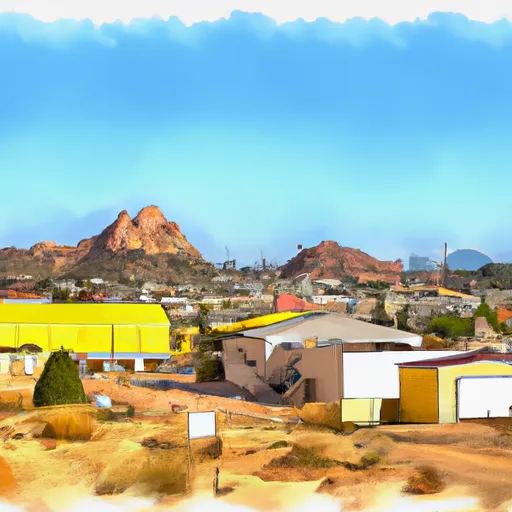-
 Snoflo Premium
Snoflo Premium
Get unlimited access to all our content
With no Ad interruptions! - Start Your Free Trial Login with existing account
Thatcher
Eden Index
Climate
8.6
•
Recreation
5.8
•
Community
2.7
•
Safeguard
6.2/10

Thatcher, Arizona is a quaint town located in Graham County, known for its pleasant climate and abundant outdoor recreation opportunities. The climate in Thatcher is typically characterized as semi-arid, with hot summers and mild winters. Summers bring scorching temperatures, often exceeding 100°F, while winters are mild with temperatures ranging from the 40s to 60s°F.
Hydrologically, Thatcher benefits from the nearby Gila River, which provides a source of water for the town and supports agricultural activities in the region. Additionally, the Pinaleno Mountains, located to the north, contribute to the hydrology of Thatcher by supplying water to the nearby Gila National Forest and contributing to the overall ecosystem.
For outdoor enthusiasts, Thatcher offers a variety of recreational opportunities. The nearby Mt. Graham provides ample hiking and camping opportunities, along with stunning panoramic views of the surrounding areas. The Gila Box Riparian National Conservation Area, located southeast of town, offers excellent opportunities for bird watching, fishing, and picnicking along the Gila River. Additionally, golf enthusiasts can enjoy the lush greens of the Mt. Graham Golf Course, while those seeking water activities can explore boating and fishing at nearby Roper Lake State Park. With its pleasant climate and diverse outdoor offerings, Thatcher is an ideal destination for nature lovers and adventure seekers.
What is the Eden Index?
The Snoflo Eden Index serves as a comprehensive rating system for regions, evaluating their desirability through a holistic assessment of climate health, outdoor recreation opportunities, and natural disaster risk, acknowledging the profound impact of these factors on livability and well-being.
Climate Health Indicator (CHI): 8.6
Thatcher receives approximately
247mm of rain per year,
with humidity levels near 46%
and air temperatures averaging around
18°C.
Thatcher has a plant hardyness factor of
8, meaning
plants and agriculture in this region tend to thrive here all year round.
By considering the ideal temperature range, reliable water supplies, clean air, and stable seasonal rain or snowpacks, the Climate Health Indicator (CHI) underscores the significance of a healthy climate as the foundation for quality living.
A healthy climate is paramount for ensuring a high quality of life and livability in a region, fostering both physical well-being and environmental harmony. This can be characterized by ideal temperatures, reliable access to water supplies, clean air, and consistent seasonal rain or snowpacks.
Weather Forecast
Streamflow Conditions
Upper Gila
Area Rivers
Upper Gila
Snowpack Depths
Upper Gila
Reservoir Storage Capacity
Upper Gila
Groundwater Levels
Recreational Opportunity Index (ROI): 5.8
The Recreational Opportunity Index (ROI) recognizes the value of outdoor recreational options, such as parks, hiking trails, camping sites, and fishing spots, while acknowledging that climate plays a pivotal role in ensuring the comfort and consistency of these experiences.
Access to outdoor recreational opportunities, encompassing activities such as parks, hiking, camping, and fishing, is crucial for overall well-being, and the climate plays a pivotal role in enabling and enhancing these experiences, ensuring that individuals can engage in nature-based activities comfortably and consistently.
Camping Areas
| Campground | Campsites | Reservations | Toilets | Showers | Elevation |
|---|---|---|---|---|---|
| Hospital Flat | 10 | 8,982 ft | |||
| Hackel Road Dispersed | None | 3,026 ft | |||
| Cunningham | 10 | 8,881 ft | |||
| Bonito | 44 | 4,033 ft | |||
| Shannon | 11 | 9,054 ft | |||
| Stockton Pass | 7 | 5,690 ft | |||
| Arcadia | 19 | 6,651 ft | |||
| Riggs Flat | 31 | 8,739 ft | |||
| Roper Lake State Park | 65 | 3,118 ft |
Nearby Fishing
Nearby Ski Areas
Catastrophe Safeguard Index (CSI):
The Catastrophe Safeguard Index (CSI) recognizes that natural disaster risk, encompassing floods, fires, hurricanes, and tornadoes, can drastically affect safety and the overall appeal of an area.
The level of natural disaster risk in a region significantly affects safety and the overall livability, with climate change amplifying these risks by potentially increasing the frequency and intensity of events like floods, fires, hurricanes, and tornadoes, thereby posing substantial challenges to community resilience and well-being.
Community Resilience Indicator (CRI): 2.7
The Community Resilience Indicator (CRI) recognizes that education, healthcare, and socioeconomics are crucial to the well-being of a region. The CRI acknowledges the profound impact of these elements on residents' overall quality of life. By evaluating educational resources, healthcare accessibility, and economic inclusivity, the index captures the essential aspects that contribute to a thriving community, fostering resident satisfaction, equity, and social cohesion.

